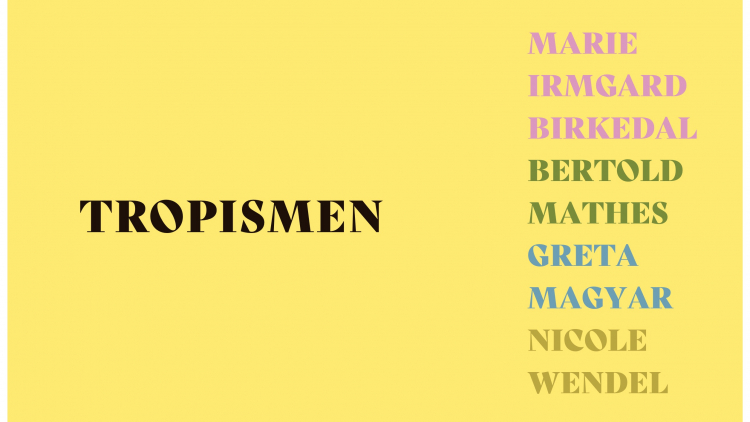
TROPISM
TROPISM
This catalogue brings together a cross-section of positions that Galerie1214 has been able to give space to in installations in Berlin and Bad Dürrheim in recent years and that it is currently presenting. As artists have always done in previous exhibitions, here we have borrowed anew a title in foreign terrain for this presentation: ‘Tropism’.
Yet, as is so often the case, it is precisely the remoteness of such a borrowing that can take the works into an open movement of thought: biology uses the term ‘tropism’ to describe the optimisation movements of organisms in relation to light, heat, and nutrients. What is meant is the constant fine ‘readjustment’ of living beings in their respective environments, which also includes the expressions of the environment and societal surroundings. A point of this understanding is the juxtaposition of self-sufficient units versus always already symbiotic orders and patterns. If the former are defined by the poles of difference and selfhood, then the latter are characterised by an interplay of demarcation and opening, mediated by the spontaneous action of the sensorium and by interception through reflection.
PRIMARY EXPERIENCE OF LIGHT
Johann Wolfgang von Goethe, with his oft-quoted and also controversial formula of the ‘sunlike quality’ of the human eye,* described the assessment that a tropism such as that of the eye to light does not merge into a purely materialistic conception such as the stimulus-response scheme, but rather turns the holding rope for our understanding, as it were, from two strands: one leads via sensory experience, the other via (often lengthily) mediated cultural concepts. To continue the example of light: in millennia-long conceptual strategies, the sun was integrated into rites, for instance as the ‘God Ra’, or abstracted as a ‘celestial body’ and ultimately classified as a ‘hydrogen-fusing dwarf star’. Nonetheless, at the same time light and warmth remain accessible to us as physical beings through knowledge as a primary experience, which art traces in drawing as an insight-giving dialogue of contour and surface, in spatial illusion as order-seeking dimensioning, or in colour as a correlate of inexhaustible emotional shading.
DEGREE ZERO OF FREEDOM
To orient oneself to something outside of us creates a sense of tension, like the positive muscular tension as the origin of a subsequent movement. Although it fulfills its meaning through its dissolution, it retains a peculiar echo in art: what lingers in the work exerts a special attraction, just as the reverberations of its choreography can interest us after a performance. Once art is made (fullfilled), it may be accepted in the situation of contemplation as a ‘degree zero’ (Roland Barthes) of freedom of sensation and creation on the part of production, as well as of seeing and sensation on the part of contemplation.
MANIFESTATION OF THE SERIES
Certainly, the spirit of the selection of the works is interdependent on the way of its making: it starts from the event of creation, which itself always has an often hidden starting point, and follows the traces that show how the act of making loses itself to a foreign land in order to find its own again – but, to paraphrase Bertolt Brecht, in an unsuspected place.
If we do not accept an equation of nature and art ‘tout court’, this is because art, in contrast to nature-given tropism, is not only integrated into the concern of artistic practice, but, as a comprehensible social practice, formally has its meaning in the fact that spontaneous expression and discipline are mirrored in each other. Art can be defined straightforwardly by the procedure of allowing creative spontaneity and reflection to work off each other in arranged scenarios of self-experience.
In short: reflection is already merged with the picture. Each painting stands on its own as a work, but for the viewer it has a special charm to follow the coordination of tension and relaxation in the serial variation of techniques or motivic ‘reproaches’, or to get involved in the permutations of the alphabet of colouristics: artistic practice summons the elemental spirits for us, abandons itself to their play, and yet orchestrates them at the same time.
ACKNOWLEDGEMENTS
The project Tropism is funded by the German Stiftung Kunstfonds as part of the NEUSTART KULTUR aid package initiated by the Federal Government Commissioner for Culture and the Media. We would like to thank the foundation and its jurors!
































